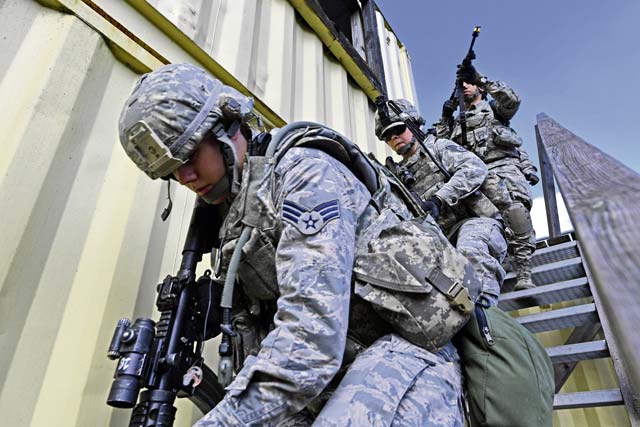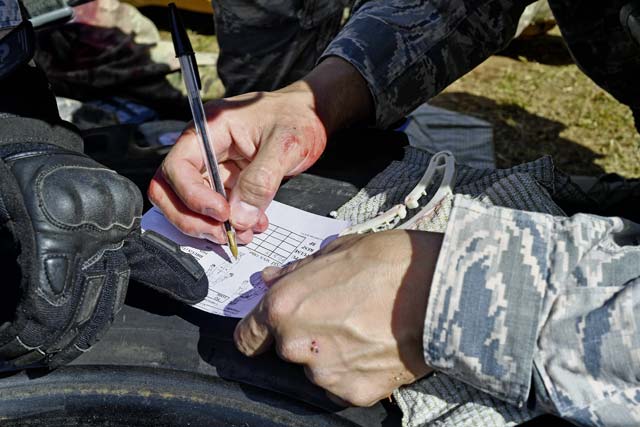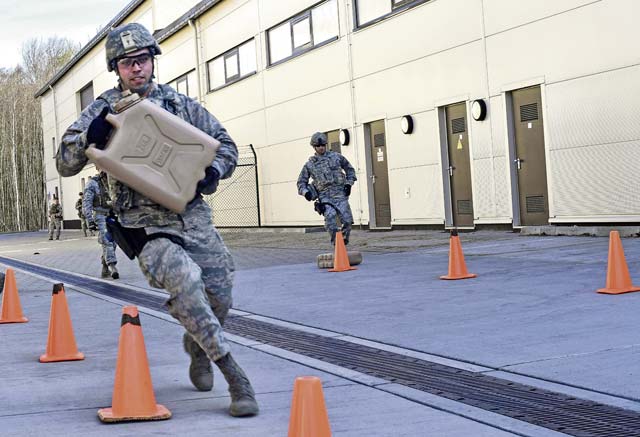
In a deployed location, one of the most important jobs falls to the security forces members who patrol, secure, and defend the base. They are relied upon to remain sharp and react with accuracy and precision to keep themselves and everyone else safe.
With such an important mission, the defenders attend a two-week refresher Security Operations Course hosted by the 435 SFS Ground Combat Readiness Training Center before deploying.
The GCRTC hosted its latest iteration of the course from March 24 to April 6.
“The purpose of the course is to provide pre-deployment training to security forces defenders,” said Staff Sgt. Mark Kegal, 435 SFS NCO in charge of SOC. “The main focus is for the squad leader to get the training he needs and to develop, hone, and improve his leadership skills to his squad so they trust him.”
The students were divided into the squads that included Airmen from the 86 SFS, 422 SFS, 100 SFS, and 569 USFPS.
“The most difficult part, I would say, is we’re all being meshed together with a bunch of people who we’ve never really spent a lot of time together,” said Senior Airman Rachel Newell, 569 USFPS patrolman and student. “Getting communication together and learning to work together as a team even though you don’t know them well enough yet is difficult.”

Throughout the course, the students received classroom and hands-on training in weapons manipulation, improvised explosive device detection, range calculation, Humvee egress training, tactical combat casualty care, live fire, and mounted, dismounted, and urban operations.
“It’s very important,” Newell said. “If you’re going out to deploy, you have to know how to get security, work with your people, and know what’s going on at all times, because you never know what’s going to happen. I think it’s good to go through this training so you’re prepared and you know how to react to certain situations.”
The last few days of the course focused on mounted, dismounted, and urban operations at U.S. Army Garrison Baumholder, where the squads took turns in each section. They were given a specific mission and had to rely on their previous training in the course to react to any situation the cadres had planned for them.
“I think my favorite part would have to be urban operations,” Newell said. “You get to go in and do room clearing, it’s a really high energy type of thing, and you always have to have your head on swivel. You never know what you’re going to find, so I think it’s exciting. It really helps out with your situational awareness, because you always have to be aware what’s around you and what you’re doing.”
While all of the training was integrated into the operations at the end of the course, providing aid for an injured team member was the most important part.
“(Tactical Combat Casualty Care) is one of the main points we like to focus on for their training,” Kegal said. “If they were to get attacked, not everyone is going to come out without some type of damage to themselves, so I think it’s extremely important to have it woven into the entire process.”
As an instructor, the urban operation was also a highlight of the course for Kegal.
“You get to see everything they learned back at Ramstein in action out here,” he said. “It will prepare them for the worst case scenario. Most likely they’re not going to get attacked, but if it does happen, they’ll have training to which they can refer back.”
Processing to deploy can be a daunting task to accomplish, but the 435 SFS ensures when security forces Airmen do arrive in their deployed location, they have the skills and knowledge they need to accomplish the mission through the GCRTC’s Security Operations Course.



